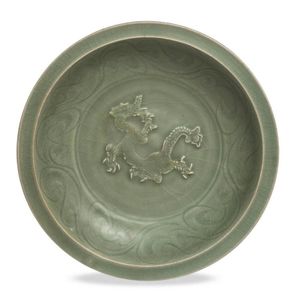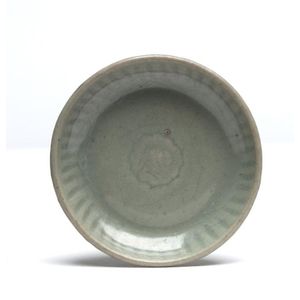Ming Dynasty Celadon Charger with Chrysanthemum Decoration
You must be a subscriber, and be logged in to view price and dealer details.
Subscribe Now to view actual auction price for this item
When you subscribe, you have the option of setting the currency in which to display prices to $Au, $US, $NZ or Stg.
- Charger - A charger is a type of large plate, typically used as a decorative base for smaller plates or bowls. They are often used in formal settings, such as at a banquet or a special occasion.
The history of chargers can be traced back to medieval times, when they were used as a base for serving dishes in banquet settings. They were typically made of metal, such as silver or pewter, and were highly decorative, often featuring intricate engravings or designs.
During the Renaissance period, chargers began to be made of porcelain, and their designs became more ornate. They were often used in the homes of the wealthy and were considered a symbol of wealth and status.
In the 18th and 19th centuries, chargers were produced in great numbers by European porcelain manufacturers, and they were exported to America and other parts of the world. They were highly sought after by the upper class and were often used as a decorative element in formal table settings. - Foliate - Decorated with leaves or leaf-like forms.
- Circa - A Latin term meaning 'about', often used in the antique trade to give an approximate date for the piece, usually considered to be five years on either side of the circa year. Thus, circa 1900 means the piece was made about 1900, probably between 1895 and 1905. The expression is sometimes abbreviated to c.1900.
- Ming Dynasty - The Ming Dynasty was a ruling dynasty of China from 1368 to 1644. It succeeded the Yuan Dynasty and preceded the Qing Dynasty. The Ming Dynasty was established by Zhu Yuanzhang, a former Buddhist monk who became a rebel leader and eventually overthrew the Mongol Yuan Dynasty. During the Ming Dynasty, China experienced a period of relative stability and prosperity. The government was centralized and bureaucratic, with the emperor at the top of the hierarchy. The Ming Dynasty is known for its cultural achievements, including the development of porcelain, the invention of movable type printing, and the construction of the Great Wall of China.
- Incised - A record of a name, date or inscription, or a decoration scratched into a surface, usually of a glass or ceramic item with a blunt instrument to make a coarse indentation. Compare with engraving where the surface is cut with a sharp instrument such as a metal needle or rotating tool to achieve a fine indentation.
This item has been included into following indexes:
Visually similar items

A large Longquan celadon dragon dish, 13th-14th century, moulded in the centre with a large dragon, the cavetto with continuous floral scrolls, the exterior with a moulded lotus petal band, 35.4 cm diameter

Three Chinese Longquan celadon vessels, late Song to Yuan dynasty, 13th-14th century, comprising a jarlet, 5.5 cm, a small dish, 10 cm diameter, and a brush washer, 13 cm diameter

A Qing dynasty Saladin bowl. 27 cm wide

A Chinese Yaozhou dish, the earthenware dish with a circular foot rim, decorated throughout the cavetto with a triangular glaze pattern and centred with a lightly moulded yin yang motif enclosed by radiating zodiac symbols, in an olive green matte glaze .
